Comprehensive Management Accounting Report: Unicorn Grocery Case Study
VerifiedAdded on 2020/02/05
|18
|5880
|102
Report
AI Summary
This report provides a comprehensive overview of management accounting principles, focusing on their application within the context of Unicorn Grocery, a co-operative grocery store. The report begins with an introduction to management accounting, differentiating it from financial accounting and outlining key areas like performance, risk, and strategic management. It then delves into various management accounting systems, including job costing, inventory management, cost accounting, and price optimization systems. The report further explores different methods used for management accounting reporting, such as job costing reports, performance reports, inventory control reports, variable analysis reports, and budgets. A significant portion of the report is dedicated to the calculation and comparison of marginal and absorption costing methods, highlighting their differences and applications. The report also covers different planning tools for budgetary control and their uses in preparing budgets. Finally, the report discusses the adoption of management accounting systems to solve financial problems and ensure the sustainable success of an organization. The content includes detailed explanations, calculations, and evaluations, making it a valuable resource for understanding and applying management accounting techniques in a practical business setting.
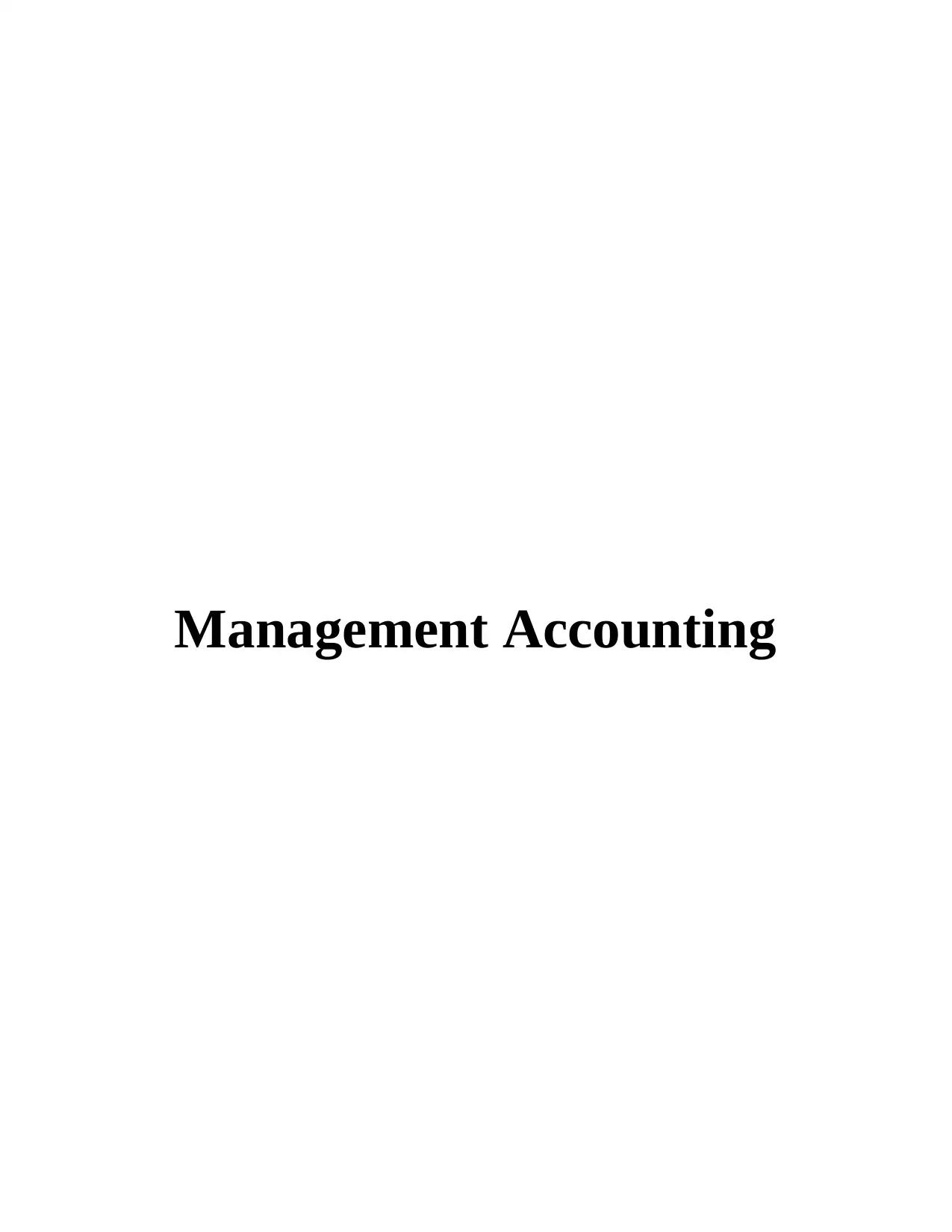
Management Accounting
Paraphrase This Document
Need a fresh take? Get an instant paraphrase of this document with our AI Paraphraser
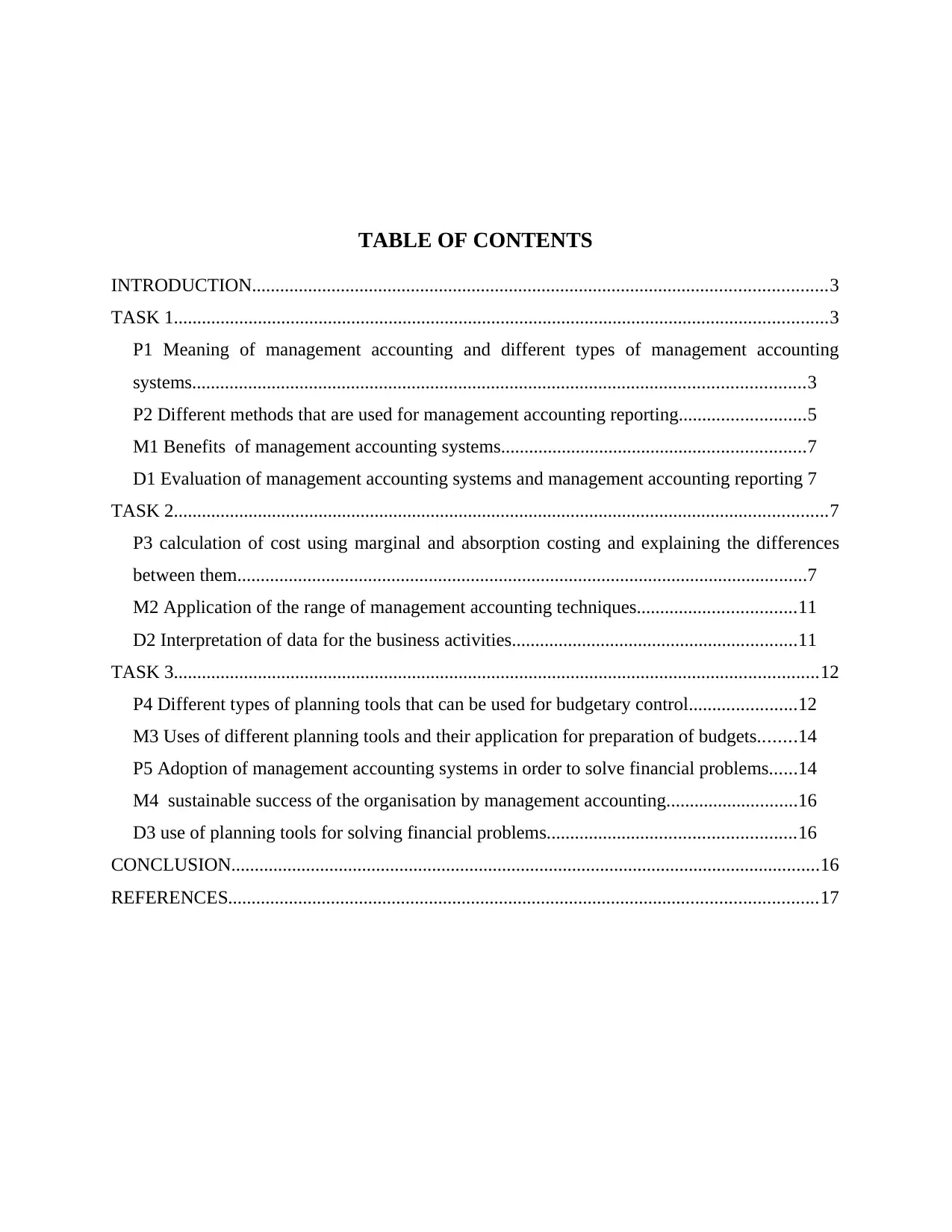
TABLE OF CONTENTS
INTRODUCTION...........................................................................................................................3
TASK 1............................................................................................................................................3
P1 Meaning of management accounting and different types of management accounting
systems...................................................................................................................................3
P2 Different methods that are used for management accounting reporting...........................5
M1 Benefits of management accounting systems.................................................................7
D1 Evaluation of management accounting systems and management accounting reporting 7
TASK 2............................................................................................................................................7
P3 calculation of cost using marginal and absorption costing and explaining the differences
between them..........................................................................................................................7
M2 Application of the range of management accounting techniques..................................11
D2 Interpretation of data for the business activities.............................................................11
TASK 3..........................................................................................................................................12
P4 Different types of planning tools that can be used for budgetary control.......................12
M3 Uses of different planning tools and their application for preparation of budgets........14
P5 Adoption of management accounting systems in order to solve financial problems......14
M4 sustainable success of the organisation by management accounting............................16
D3 use of planning tools for solving financial problems.....................................................16
CONCLUSION..............................................................................................................................16
REFERENCES..............................................................................................................................17
INTRODUCTION...........................................................................................................................3
TASK 1............................................................................................................................................3
P1 Meaning of management accounting and different types of management accounting
systems...................................................................................................................................3
P2 Different methods that are used for management accounting reporting...........................5
M1 Benefits of management accounting systems.................................................................7
D1 Evaluation of management accounting systems and management accounting reporting 7
TASK 2............................................................................................................................................7
P3 calculation of cost using marginal and absorption costing and explaining the differences
between them..........................................................................................................................7
M2 Application of the range of management accounting techniques..................................11
D2 Interpretation of data for the business activities.............................................................11
TASK 3..........................................................................................................................................12
P4 Different types of planning tools that can be used for budgetary control.......................12
M3 Uses of different planning tools and their application for preparation of budgets........14
P5 Adoption of management accounting systems in order to solve financial problems......14
M4 sustainable success of the organisation by management accounting............................16
D3 use of planning tools for solving financial problems.....................................................16
CONCLUSION..............................................................................................................................16
REFERENCES..............................................................................................................................17
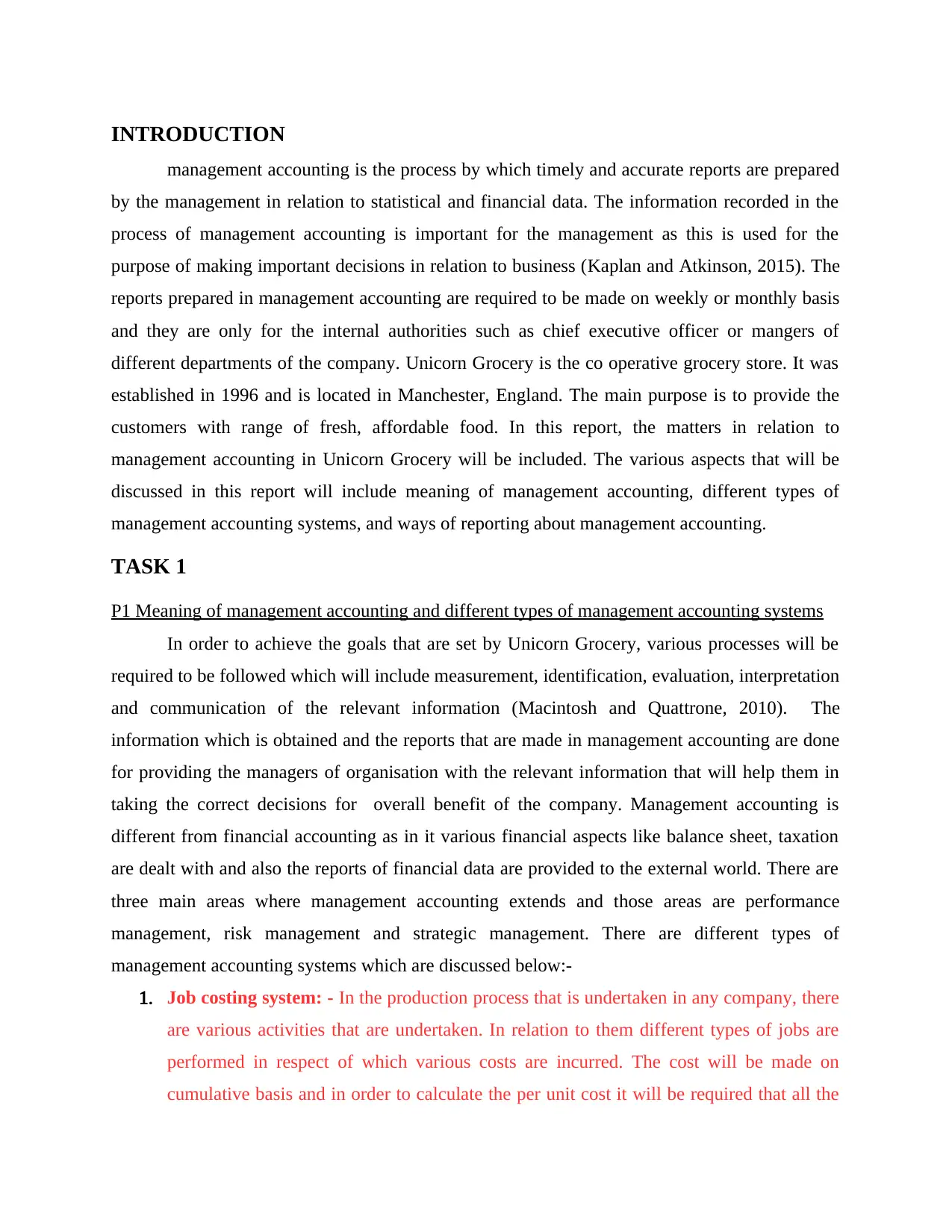
INTRODUCTION
management accounting is the process by which timely and accurate reports are prepared
by the management in relation to statistical and financial data. The information recorded in the
process of management accounting is important for the management as this is used for the
purpose of making important decisions in relation to business (Kaplan and Atkinson, 2015). The
reports prepared in management accounting are required to be made on weekly or monthly basis
and they are only for the internal authorities such as chief executive officer or mangers of
different departments of the company. Unicorn Grocery is the co operative grocery store. It was
established in 1996 and is located in Manchester, England. The main purpose is to provide the
customers with range of fresh, affordable food. In this report, the matters in relation to
management accounting in Unicorn Grocery will be included. The various aspects that will be
discussed in this report will include meaning of management accounting, different types of
management accounting systems, and ways of reporting about management accounting.
TASK 1
P1 Meaning of management accounting and different types of management accounting systems
In order to achieve the goals that are set by Unicorn Grocery, various processes will be
required to be followed which will include measurement, identification, evaluation, interpretation
and communication of the relevant information (Macintosh and Quattrone, 2010). The
information which is obtained and the reports that are made in management accounting are done
for providing the managers of organisation with the relevant information that will help them in
taking the correct decisions for overall benefit of the company. Management accounting is
different from financial accounting as in it various financial aspects like balance sheet, taxation
are dealt with and also the reports of financial data are provided to the external world. There are
three main areas where management accounting extends and those areas are performance
management, risk management and strategic management. There are different types of
management accounting systems which are discussed below:-
1. Job costing system: - In the production process that is undertaken in any company, there
are various activities that are undertaken. In relation to them different types of jobs are
performed in respect of which various costs are incurred. The cost will be made on
cumulative basis and in order to calculate the per unit cost it will be required that all the
management accounting is the process by which timely and accurate reports are prepared
by the management in relation to statistical and financial data. The information recorded in the
process of management accounting is important for the management as this is used for the
purpose of making important decisions in relation to business (Kaplan and Atkinson, 2015). The
reports prepared in management accounting are required to be made on weekly or monthly basis
and they are only for the internal authorities such as chief executive officer or mangers of
different departments of the company. Unicorn Grocery is the co operative grocery store. It was
established in 1996 and is located in Manchester, England. The main purpose is to provide the
customers with range of fresh, affordable food. In this report, the matters in relation to
management accounting in Unicorn Grocery will be included. The various aspects that will be
discussed in this report will include meaning of management accounting, different types of
management accounting systems, and ways of reporting about management accounting.
TASK 1
P1 Meaning of management accounting and different types of management accounting systems
In order to achieve the goals that are set by Unicorn Grocery, various processes will be
required to be followed which will include measurement, identification, evaluation, interpretation
and communication of the relevant information (Macintosh and Quattrone, 2010). The
information which is obtained and the reports that are made in management accounting are done
for providing the managers of organisation with the relevant information that will help them in
taking the correct decisions for overall benefit of the company. Management accounting is
different from financial accounting as in it various financial aspects like balance sheet, taxation
are dealt with and also the reports of financial data are provided to the external world. There are
three main areas where management accounting extends and those areas are performance
management, risk management and strategic management. There are different types of
management accounting systems which are discussed below:-
1. Job costing system: - In the production process that is undertaken in any company, there
are various activities that are undertaken. In relation to them different types of jobs are
performed in respect of which various costs are incurred. The cost will be made on
cumulative basis and in order to calculate the per unit cost it will be required that all the
⊘ This is a preview!⊘
Do you want full access?
Subscribe today to unlock all pages.

Trusted by 1+ million students worldwide
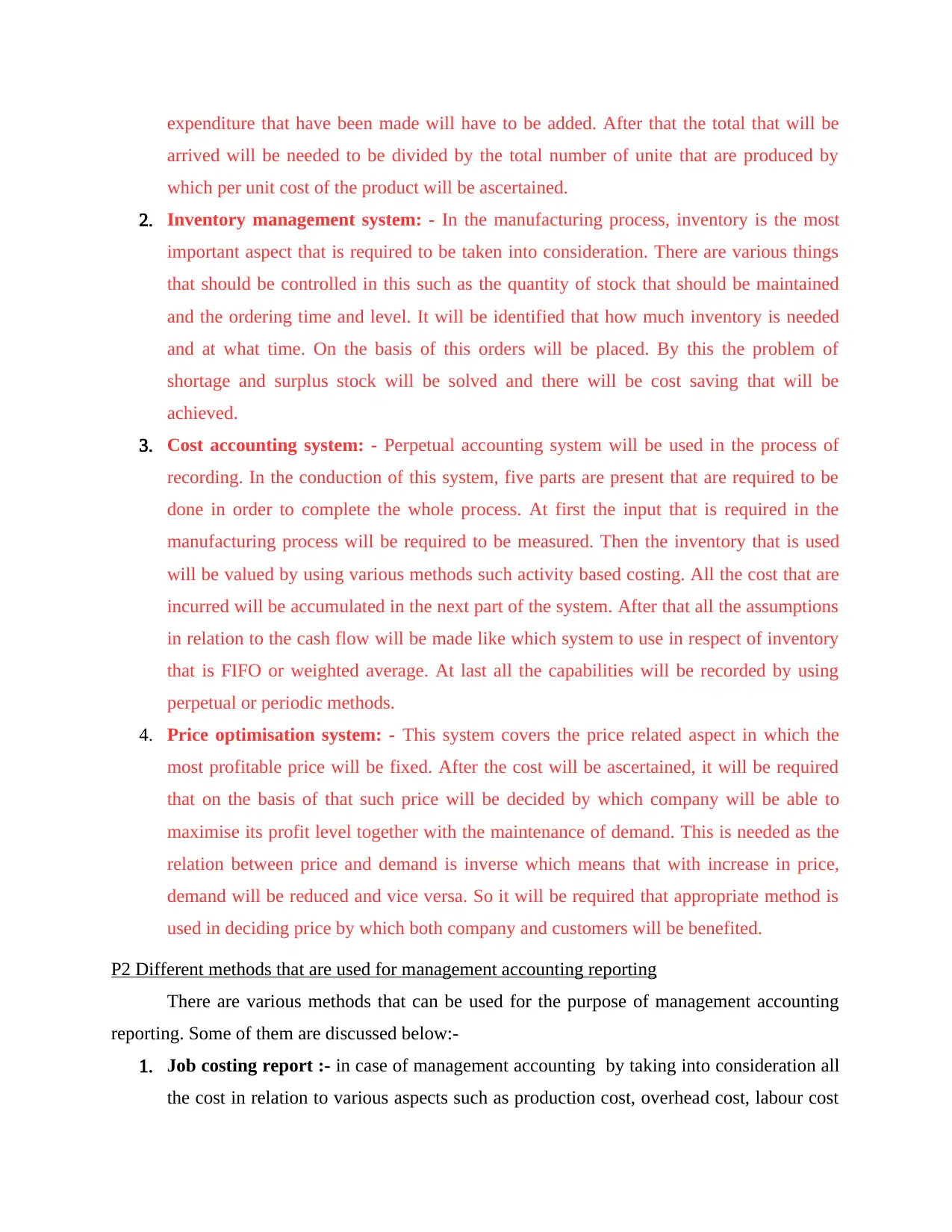
expenditure that have been made will have to be added. After that the total that will be
arrived will be needed to be divided by the total number of unite that are produced by
which per unit cost of the product will be ascertained.
2. Inventory management system: - In the manufacturing process, inventory is the most
important aspect that is required to be taken into consideration. There are various things
that should be controlled in this such as the quantity of stock that should be maintained
and the ordering time and level. It will be identified that how much inventory is needed
and at what time. On the basis of this orders will be placed. By this the problem of
shortage and surplus stock will be solved and there will be cost saving that will be
achieved.
3. Cost accounting system: - Perpetual accounting system will be used in the process of
recording. In the conduction of this system, five parts are present that are required to be
done in order to complete the whole process. At first the input that is required in the
manufacturing process will be required to be measured. Then the inventory that is used
will be valued by using various methods such activity based costing. All the cost that are
incurred will be accumulated in the next part of the system. After that all the assumptions
in relation to the cash flow will be made like which system to use in respect of inventory
that is FIFO or weighted average. At last all the capabilities will be recorded by using
perpetual or periodic methods.
4. Price optimisation system: - This system covers the price related aspect in which the
most profitable price will be fixed. After the cost will be ascertained, it will be required
that on the basis of that such price will be decided by which company will be able to
maximise its profit level together with the maintenance of demand. This is needed as the
relation between price and demand is inverse which means that with increase in price,
demand will be reduced and vice versa. So it will be required that appropriate method is
used in deciding price by which both company and customers will be benefited.
P2 Different methods that are used for management accounting reporting
There are various methods that can be used for the purpose of management accounting
reporting. Some of them are discussed below:-
1. Job costing report :- in case of management accounting by taking into consideration all
the cost in relation to various aspects such as production cost, overhead cost, labour cost
arrived will be needed to be divided by the total number of unite that are produced by
which per unit cost of the product will be ascertained.
2. Inventory management system: - In the manufacturing process, inventory is the most
important aspect that is required to be taken into consideration. There are various things
that should be controlled in this such as the quantity of stock that should be maintained
and the ordering time and level. It will be identified that how much inventory is needed
and at what time. On the basis of this orders will be placed. By this the problem of
shortage and surplus stock will be solved and there will be cost saving that will be
achieved.
3. Cost accounting system: - Perpetual accounting system will be used in the process of
recording. In the conduction of this system, five parts are present that are required to be
done in order to complete the whole process. At first the input that is required in the
manufacturing process will be required to be measured. Then the inventory that is used
will be valued by using various methods such activity based costing. All the cost that are
incurred will be accumulated in the next part of the system. After that all the assumptions
in relation to the cash flow will be made like which system to use in respect of inventory
that is FIFO or weighted average. At last all the capabilities will be recorded by using
perpetual or periodic methods.
4. Price optimisation system: - This system covers the price related aspect in which the
most profitable price will be fixed. After the cost will be ascertained, it will be required
that on the basis of that such price will be decided by which company will be able to
maximise its profit level together with the maintenance of demand. This is needed as the
relation between price and demand is inverse which means that with increase in price,
demand will be reduced and vice versa. So it will be required that appropriate method is
used in deciding price by which both company and customers will be benefited.
P2 Different methods that are used for management accounting reporting
There are various methods that can be used for the purpose of management accounting
reporting. Some of them are discussed below:-
1. Job costing report :- in case of management accounting by taking into consideration all
the cost in relation to various aspects such as production cost, overhead cost, labour cost
Paraphrase This Document
Need a fresh take? Get an instant paraphrase of this document with our AI Paraphraser
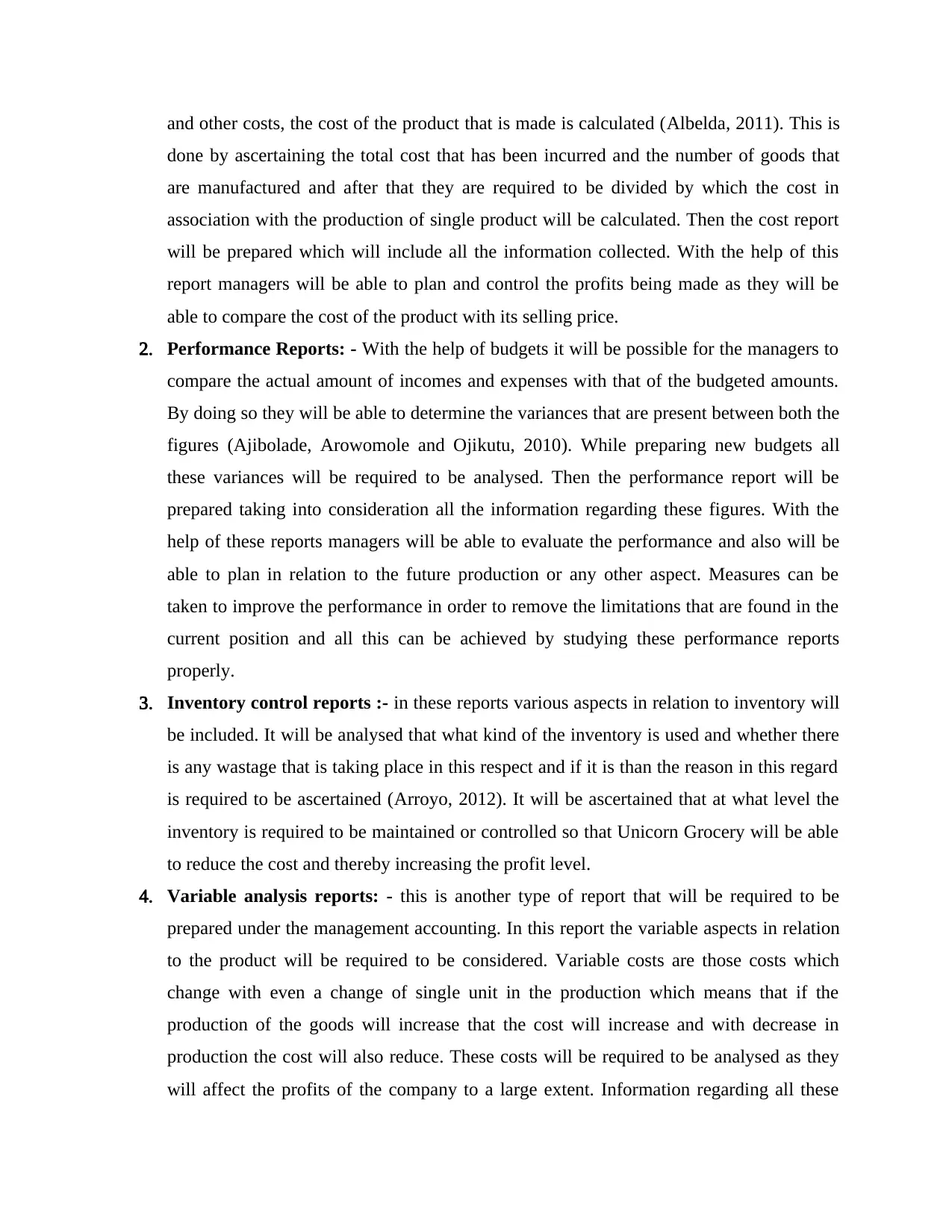
and other costs, the cost of the product that is made is calculated (Albelda, 2011). This is
done by ascertaining the total cost that has been incurred and the number of goods that
are manufactured and after that they are required to be divided by which the cost in
association with the production of single product will be calculated. Then the cost report
will be prepared which will include all the information collected. With the help of this
report managers will be able to plan and control the profits being made as they will be
able to compare the cost of the product with its selling price.
2. Performance Reports: - With the help of budgets it will be possible for the managers to
compare the actual amount of incomes and expenses with that of the budgeted amounts.
By doing so they will be able to determine the variances that are present between both the
figures (Ajibolade, Arowomole and Ojikutu, 2010). While preparing new budgets all
these variances will be required to be analysed. Then the performance report will be
prepared taking into consideration all the information regarding these figures. With the
help of these reports managers will be able to evaluate the performance and also will be
able to plan in relation to the future production or any other aspect. Measures can be
taken to improve the performance in order to remove the limitations that are found in the
current position and all this can be achieved by studying these performance reports
properly.
3. Inventory control reports :- in these reports various aspects in relation to inventory will
be included. It will be analysed that what kind of the inventory is used and whether there
is any wastage that is taking place in this respect and if it is than the reason in this regard
is required to be ascertained (Arroyo, 2012). It will be ascertained that at what level the
inventory is required to be maintained or controlled so that Unicorn Grocery will be able
to reduce the cost and thereby increasing the profit level.
4. Variable analysis reports: - this is another type of report that will be required to be
prepared under the management accounting. In this report the variable aspects in relation
to the product will be required to be considered. Variable costs are those costs which
change with even a change of single unit in the production which means that if the
production of the goods will increase that the cost will increase and with decrease in
production the cost will also reduce. These costs will be required to be analysed as they
will affect the profits of the company to a large extent. Information regarding all these
done by ascertaining the total cost that has been incurred and the number of goods that
are manufactured and after that they are required to be divided by which the cost in
association with the production of single product will be calculated. Then the cost report
will be prepared which will include all the information collected. With the help of this
report managers will be able to plan and control the profits being made as they will be
able to compare the cost of the product with its selling price.
2. Performance Reports: - With the help of budgets it will be possible for the managers to
compare the actual amount of incomes and expenses with that of the budgeted amounts.
By doing so they will be able to determine the variances that are present between both the
figures (Ajibolade, Arowomole and Ojikutu, 2010). While preparing new budgets all
these variances will be required to be analysed. Then the performance report will be
prepared taking into consideration all the information regarding these figures. With the
help of these reports managers will be able to evaluate the performance and also will be
able to plan in relation to the future production or any other aspect. Measures can be
taken to improve the performance in order to remove the limitations that are found in the
current position and all this can be achieved by studying these performance reports
properly.
3. Inventory control reports :- in these reports various aspects in relation to inventory will
be included. It will be analysed that what kind of the inventory is used and whether there
is any wastage that is taking place in this respect and if it is than the reason in this regard
is required to be ascertained (Arroyo, 2012). It will be ascertained that at what level the
inventory is required to be maintained or controlled so that Unicorn Grocery will be able
to reduce the cost and thereby increasing the profit level.
4. Variable analysis reports: - this is another type of report that will be required to be
prepared under the management accounting. In this report the variable aspects in relation
to the product will be required to be considered. Variable costs are those costs which
change with even a change of single unit in the production which means that if the
production of the goods will increase that the cost will increase and with decrease in
production the cost will also reduce. These costs will be required to be analysed as they
will affect the profits of the company to a large extent. Information regarding all these
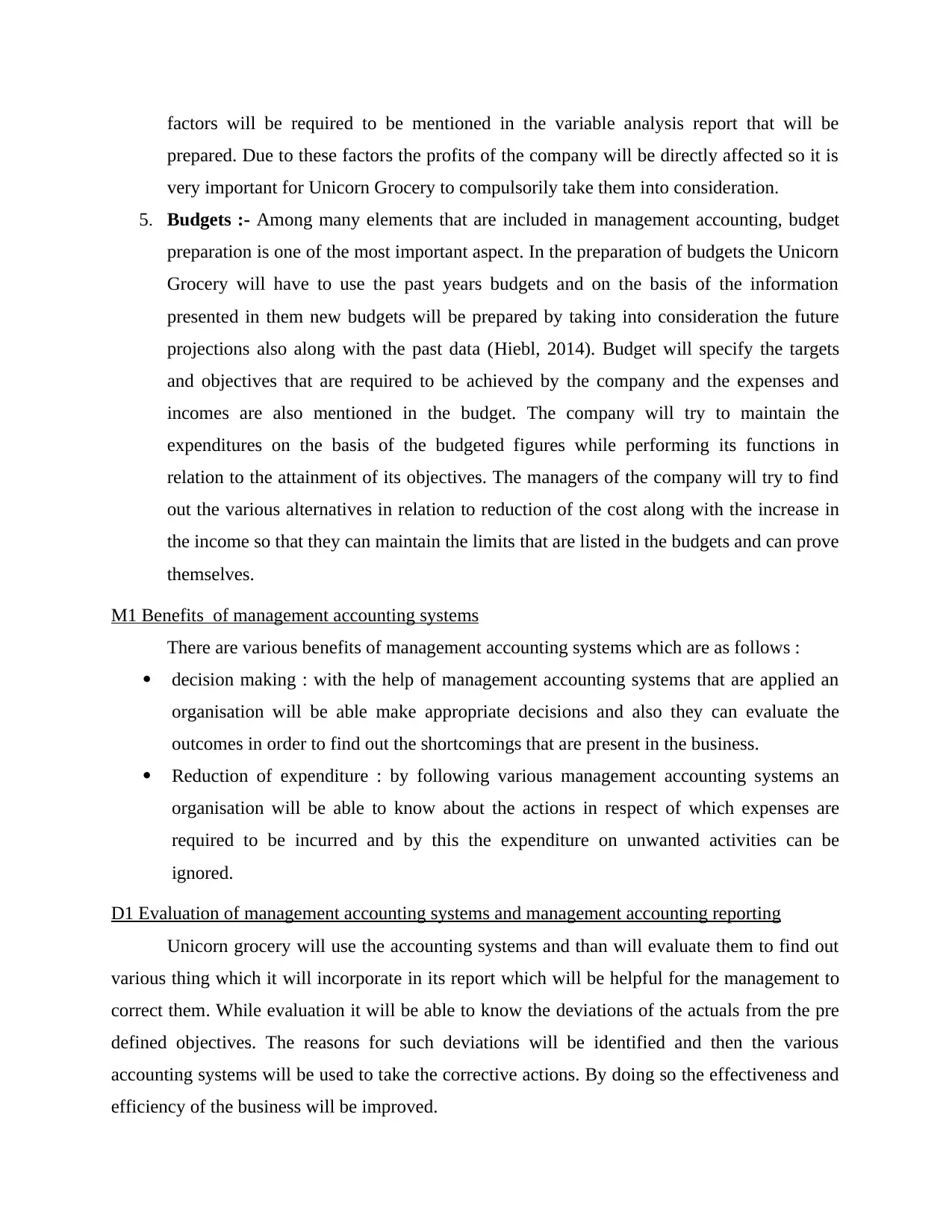
factors will be required to be mentioned in the variable analysis report that will be
prepared. Due to these factors the profits of the company will be directly affected so it is
very important for Unicorn Grocery to compulsorily take them into consideration.
5. Budgets :- Among many elements that are included in management accounting, budget
preparation is one of the most important aspect. In the preparation of budgets the Unicorn
Grocery will have to use the past years budgets and on the basis of the information
presented in them new budgets will be prepared by taking into consideration the future
projections also along with the past data (Hiebl, 2014). Budget will specify the targets
and objectives that are required to be achieved by the company and the expenses and
incomes are also mentioned in the budget. The company will try to maintain the
expenditures on the basis of the budgeted figures while performing its functions in
relation to the attainment of its objectives. The managers of the company will try to find
out the various alternatives in relation to reduction of the cost along with the increase in
the income so that they can maintain the limits that are listed in the budgets and can prove
themselves.
M1 Benefits of management accounting systems
There are various benefits of management accounting systems which are as follows :
decision making : with the help of management accounting systems that are applied an
organisation will be able make appropriate decisions and also they can evaluate the
outcomes in order to find out the shortcomings that are present in the business.
Reduction of expenditure : by following various management accounting systems an
organisation will be able to know about the actions in respect of which expenses are
required to be incurred and by this the expenditure on unwanted activities can be
ignored.
D1 Evaluation of management accounting systems and management accounting reporting
Unicorn grocery will use the accounting systems and than will evaluate them to find out
various thing which it will incorporate in its report which will be helpful for the management to
correct them. While evaluation it will be able to know the deviations of the actuals from the pre
defined objectives. The reasons for such deviations will be identified and then the various
accounting systems will be used to take the corrective actions. By doing so the effectiveness and
efficiency of the business will be improved.
prepared. Due to these factors the profits of the company will be directly affected so it is
very important for Unicorn Grocery to compulsorily take them into consideration.
5. Budgets :- Among many elements that are included in management accounting, budget
preparation is one of the most important aspect. In the preparation of budgets the Unicorn
Grocery will have to use the past years budgets and on the basis of the information
presented in them new budgets will be prepared by taking into consideration the future
projections also along with the past data (Hiebl, 2014). Budget will specify the targets
and objectives that are required to be achieved by the company and the expenses and
incomes are also mentioned in the budget. The company will try to maintain the
expenditures on the basis of the budgeted figures while performing its functions in
relation to the attainment of its objectives. The managers of the company will try to find
out the various alternatives in relation to reduction of the cost along with the increase in
the income so that they can maintain the limits that are listed in the budgets and can prove
themselves.
M1 Benefits of management accounting systems
There are various benefits of management accounting systems which are as follows :
decision making : with the help of management accounting systems that are applied an
organisation will be able make appropriate decisions and also they can evaluate the
outcomes in order to find out the shortcomings that are present in the business.
Reduction of expenditure : by following various management accounting systems an
organisation will be able to know about the actions in respect of which expenses are
required to be incurred and by this the expenditure on unwanted activities can be
ignored.
D1 Evaluation of management accounting systems and management accounting reporting
Unicorn grocery will use the accounting systems and than will evaluate them to find out
various thing which it will incorporate in its report which will be helpful for the management to
correct them. While evaluation it will be able to know the deviations of the actuals from the pre
defined objectives. The reasons for such deviations will be identified and then the various
accounting systems will be used to take the corrective actions. By doing so the effectiveness and
efficiency of the business will be improved.
⊘ This is a preview!⊘
Do you want full access?
Subscribe today to unlock all pages.

Trusted by 1+ million students worldwide
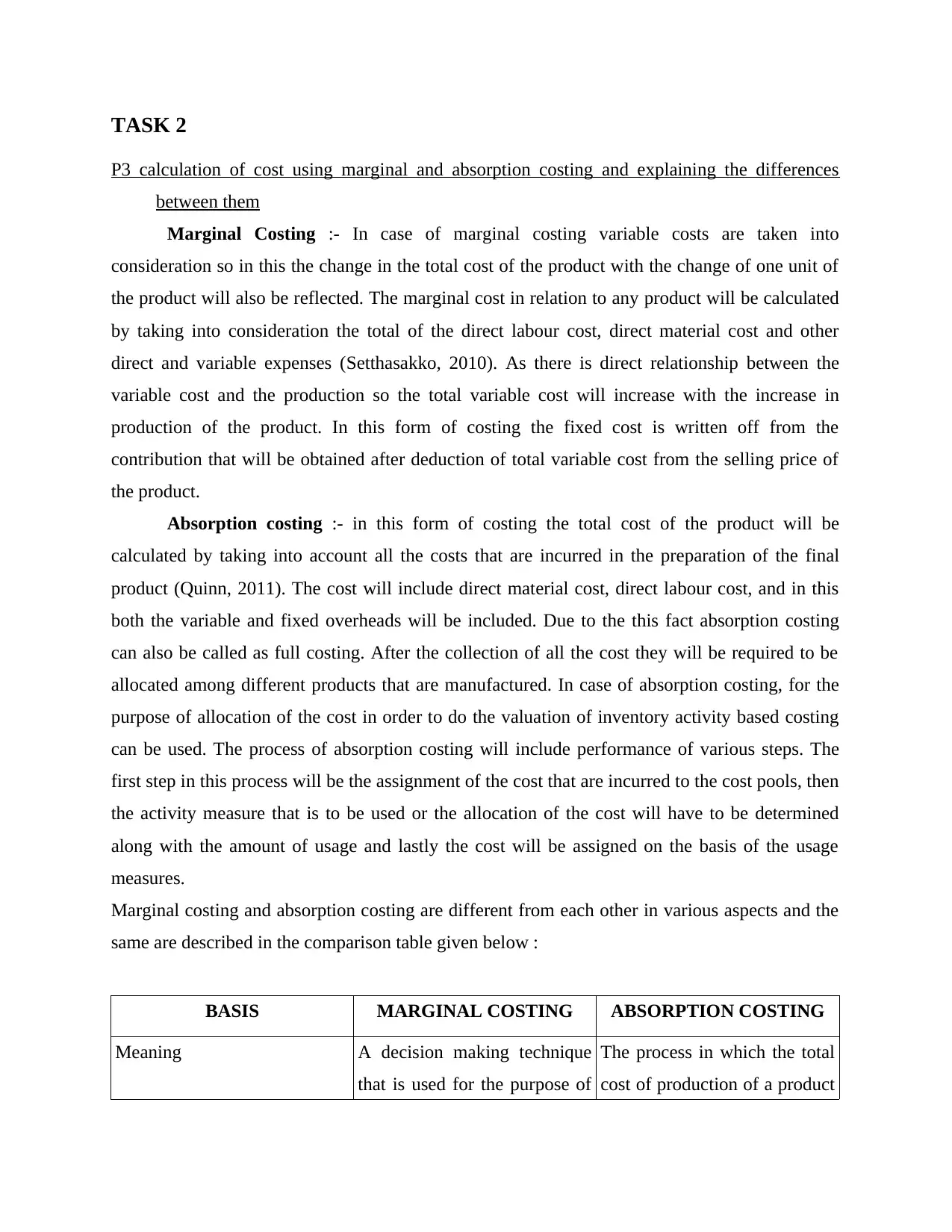
TASK 2
P3 calculation of cost using marginal and absorption costing and explaining the differences
between them
Marginal Costing :- In case of marginal costing variable costs are taken into
consideration so in this the change in the total cost of the product with the change of one unit of
the product will also be reflected. The marginal cost in relation to any product will be calculated
by taking into consideration the total of the direct labour cost, direct material cost and other
direct and variable expenses (Setthasakko, 2010). As there is direct relationship between the
variable cost and the production so the total variable cost will increase with the increase in
production of the product. In this form of costing the fixed cost is written off from the
contribution that will be obtained after deduction of total variable cost from the selling price of
the product.
Absorption costing :- in this form of costing the total cost of the product will be
calculated by taking into account all the costs that are incurred in the preparation of the final
product (Quinn, 2011). The cost will include direct material cost, direct labour cost, and in this
both the variable and fixed overheads will be included. Due to the this fact absorption costing
can also be called as full costing. After the collection of all the cost they will be required to be
allocated among different products that are manufactured. In case of absorption costing, for the
purpose of allocation of the cost in order to do the valuation of inventory activity based costing
can be used. The process of absorption costing will include performance of various steps. The
first step in this process will be the assignment of the cost that are incurred to the cost pools, then
the activity measure that is to be used or the allocation of the cost will have to be determined
along with the amount of usage and lastly the cost will be assigned on the basis of the usage
measures.
Marginal costing and absorption costing are different from each other in various aspects and the
same are described in the comparison table given below :
BASIS MARGINAL COSTING ABSORPTION COSTING
Meaning A decision making technique
that is used for the purpose of
The process in which the total
cost of production of a product
P3 calculation of cost using marginal and absorption costing and explaining the differences
between them
Marginal Costing :- In case of marginal costing variable costs are taken into
consideration so in this the change in the total cost of the product with the change of one unit of
the product will also be reflected. The marginal cost in relation to any product will be calculated
by taking into consideration the total of the direct labour cost, direct material cost and other
direct and variable expenses (Setthasakko, 2010). As there is direct relationship between the
variable cost and the production so the total variable cost will increase with the increase in
production of the product. In this form of costing the fixed cost is written off from the
contribution that will be obtained after deduction of total variable cost from the selling price of
the product.
Absorption costing :- in this form of costing the total cost of the product will be
calculated by taking into account all the costs that are incurred in the preparation of the final
product (Quinn, 2011). The cost will include direct material cost, direct labour cost, and in this
both the variable and fixed overheads will be included. Due to the this fact absorption costing
can also be called as full costing. After the collection of all the cost they will be required to be
allocated among different products that are manufactured. In case of absorption costing, for the
purpose of allocation of the cost in order to do the valuation of inventory activity based costing
can be used. The process of absorption costing will include performance of various steps. The
first step in this process will be the assignment of the cost that are incurred to the cost pools, then
the activity measure that is to be used or the allocation of the cost will have to be determined
along with the amount of usage and lastly the cost will be assigned on the basis of the usage
measures.
Marginal costing and absorption costing are different from each other in various aspects and the
same are described in the comparison table given below :
BASIS MARGINAL COSTING ABSORPTION COSTING
Meaning A decision making technique
that is used for the purpose of
The process in which the total
cost of production of a product
Paraphrase This Document
Need a fresh take? Get an instant paraphrase of this document with our AI Paraphraser
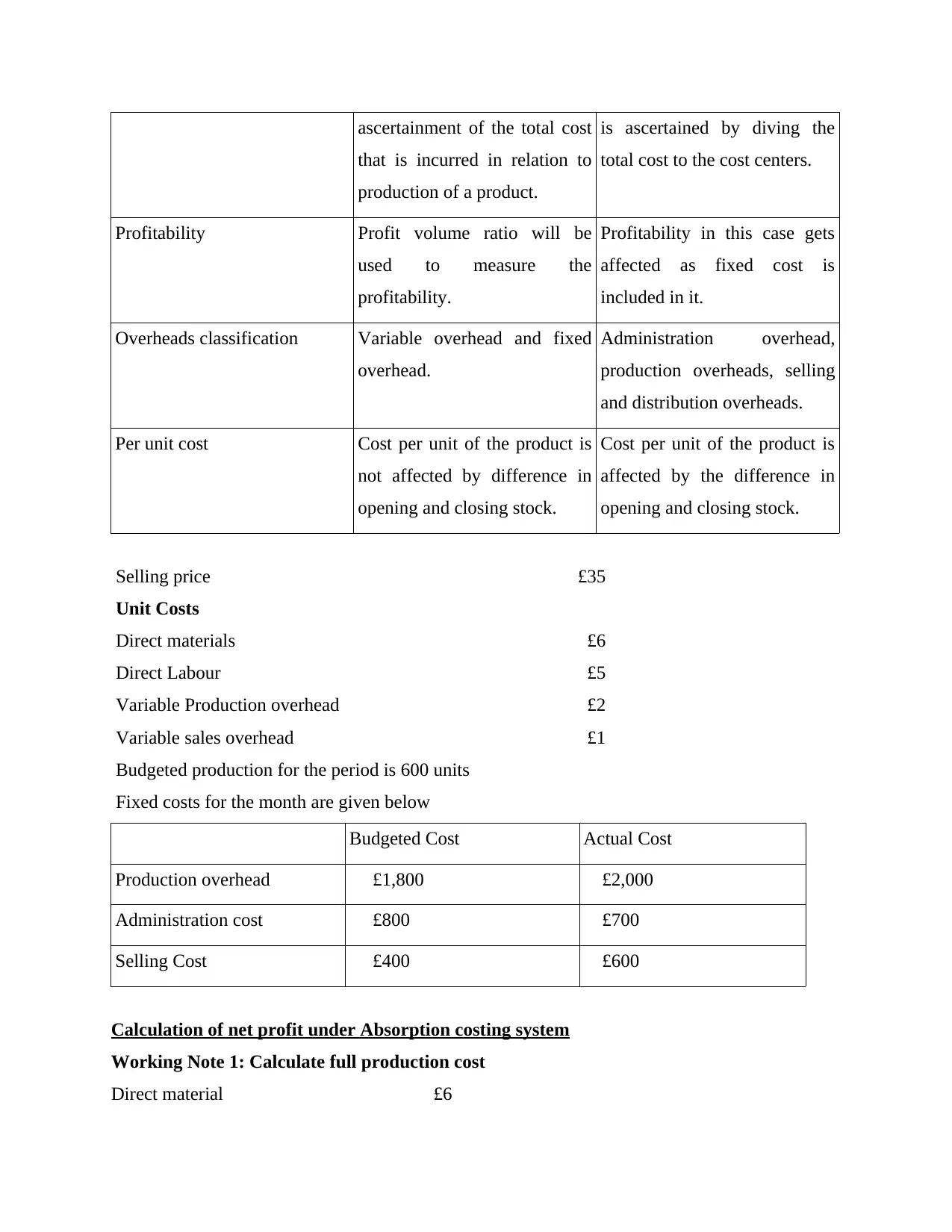
ascertainment of the total cost
that is incurred in relation to
production of a product.
is ascertained by diving the
total cost to the cost centers.
Profitability Profit volume ratio will be
used to measure the
profitability.
Profitability in this case gets
affected as fixed cost is
included in it.
Overheads classification Variable overhead and fixed
overhead.
Administration overhead,
production overheads, selling
and distribution overheads.
Per unit cost Cost per unit of the product is
not affected by difference in
opening and closing stock.
Cost per unit of the product is
affected by the difference in
opening and closing stock.
Selling price £35
Unit Costs
Direct materials £6
Direct Labour £5
Variable Production overhead £2
Variable sales overhead £1
Budgeted production for the period is 600 units
Fixed costs for the month are given below
Budgeted Cost Actual Cost
Production overhead £1,800 £2,000
Administration cost £800 £700
Selling Cost £400 £600
Calculation of net profit under Absorption costing system
Working Note 1: Calculate full production cost
Direct material £6
that is incurred in relation to
production of a product.
is ascertained by diving the
total cost to the cost centers.
Profitability Profit volume ratio will be
used to measure the
profitability.
Profitability in this case gets
affected as fixed cost is
included in it.
Overheads classification Variable overhead and fixed
overhead.
Administration overhead,
production overheads, selling
and distribution overheads.
Per unit cost Cost per unit of the product is
not affected by difference in
opening and closing stock.
Cost per unit of the product is
affected by the difference in
opening and closing stock.
Selling price £35
Unit Costs
Direct materials £6
Direct Labour £5
Variable Production overhead £2
Variable sales overhead £1
Budgeted production for the period is 600 units
Fixed costs for the month are given below
Budgeted Cost Actual Cost
Production overhead £1,800 £2,000
Administration cost £800 £700
Selling Cost £400 £600
Calculation of net profit under Absorption costing system
Working Note 1: Calculate full production cost
Direct material £6

Direct labour £5
Variable cost £3
Fixed cost £5
Total £19
Working Note 2: Calculate value of inventory and production
Opening inventory Production Closing inventory
0 700*19 = £13300 100*19 = £1900
Working Note 3: under/ over absorbed fixed production overhead
Actual fixed production: £3300
Fixed overhead: £3500
Total £200(over absorbed)
Income Statement
Particulars Amount Amount
Sales
Less: Cost of Sales:
Opening inventory
Production
Closing inventory
(Under)/ Over absorbed fixed prod. O/h
Gross Profit
Less Expenses
Variable sales
Fixed administration
Fixed selling
Net Profit
Nil
13300
(1900)
1800
700
600
21000
(11400)
200
9800
(3100)
6700
Calculation of net profit under marginal costing system
Variable cost £3
Fixed cost £5
Total £19
Working Note 2: Calculate value of inventory and production
Opening inventory Production Closing inventory
0 700*19 = £13300 100*19 = £1900
Working Note 3: under/ over absorbed fixed production overhead
Actual fixed production: £3300
Fixed overhead: £3500
Total £200(over absorbed)
Income Statement
Particulars Amount Amount
Sales
Less: Cost of Sales:
Opening inventory
Production
Closing inventory
(Under)/ Over absorbed fixed prod. O/h
Gross Profit
Less Expenses
Variable sales
Fixed administration
Fixed selling
Net Profit
Nil
13300
(1900)
1800
700
600
21000
(11400)
200
9800
(3100)
6700
Calculation of net profit under marginal costing system
⊘ This is a preview!⊘
Do you want full access?
Subscribe today to unlock all pages.

Trusted by 1+ million students worldwide

Working Note 1: Calculate variable production cost £
Direct material 6
Direct labour 5
Variable production O/H 3
Variable production cost 14
Working Note 2: Calculate value of inventory and production
Opening inventory Production Closing inventory
0 700*14 = 9800 100*14 = 1400
Income statements under marginal costing system
Particulars Amount Amount
Sales
Less:Variable costs
Opening inventory
Production
Closing inventory
Variable sales
Contribution
Less:Fixed costs
Fixed Production overhead
Administration cost
Selling cost
Net Profit
Nil
9800
(1400)
2000
700
600
21000
(8400)
(1800)
10800
(3300)
7500
M2 Application of the range of management accounting techniques.
There are various techniques that are used by an organisation with the help of which they
can manage their accounts and also can take better decisions which will be of great advantage for
the company. Such techniques which are used are management accounting techniques. Some of
the techniques are preparation of budgets or making plans for the future which will describe what
an organisation has to do and what are the targets that are required to be achieved by them in
order to ensure the success of the business.
Direct material 6
Direct labour 5
Variable production O/H 3
Variable production cost 14
Working Note 2: Calculate value of inventory and production
Opening inventory Production Closing inventory
0 700*14 = 9800 100*14 = 1400
Income statements under marginal costing system
Particulars Amount Amount
Sales
Less:Variable costs
Opening inventory
Production
Closing inventory
Variable sales
Contribution
Less:Fixed costs
Fixed Production overhead
Administration cost
Selling cost
Net Profit
Nil
9800
(1400)
2000
700
600
21000
(8400)
(1800)
10800
(3300)
7500
M2 Application of the range of management accounting techniques.
There are various techniques that are used by an organisation with the help of which they
can manage their accounts and also can take better decisions which will be of great advantage for
the company. Such techniques which are used are management accounting techniques. Some of
the techniques are preparation of budgets or making plans for the future which will describe what
an organisation has to do and what are the targets that are required to be achieved by them in
order to ensure the success of the business.
Paraphrase This Document
Need a fresh take? Get an instant paraphrase of this document with our AI Paraphraser
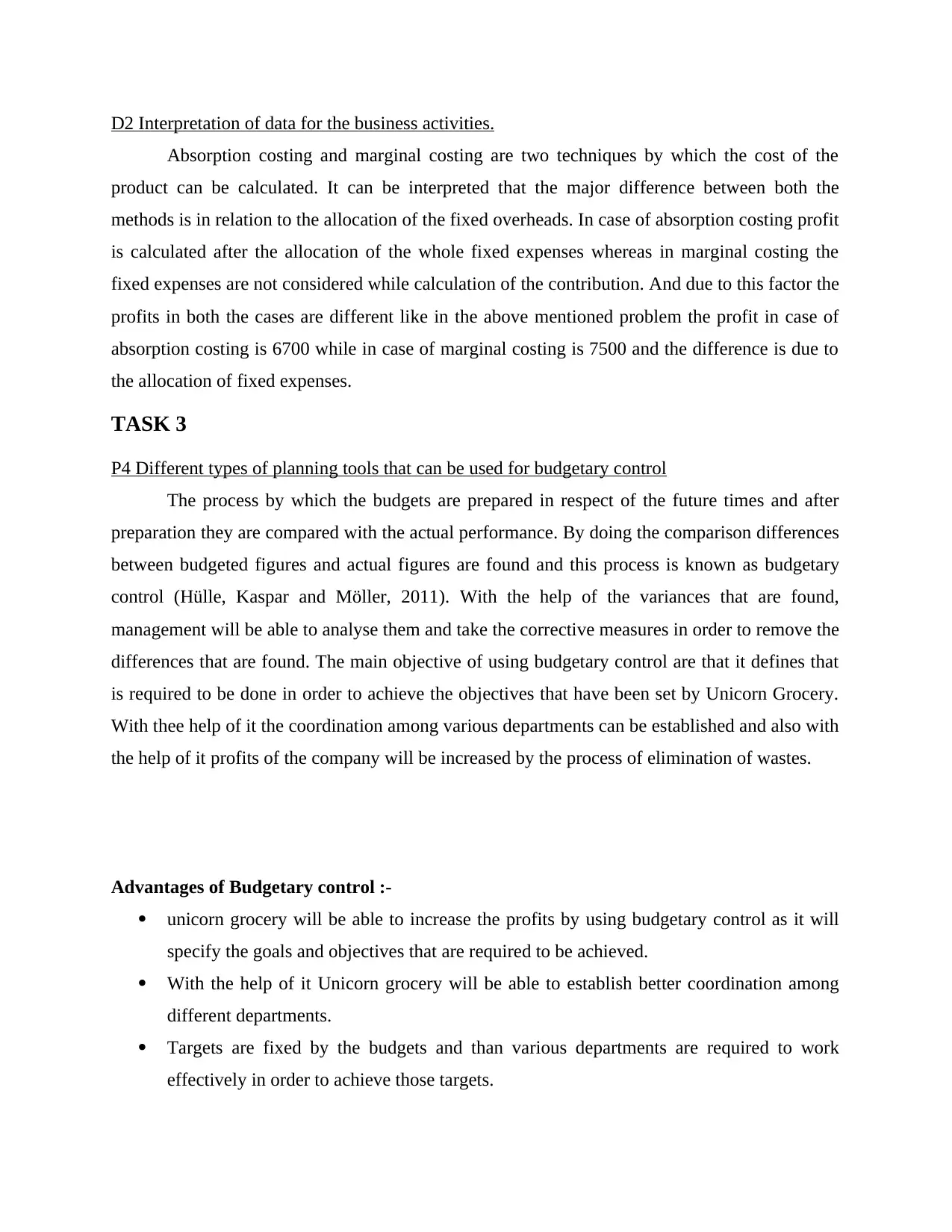
D2 Interpretation of data for the business activities.
Absorption costing and marginal costing are two techniques by which the cost of the
product can be calculated. It can be interpreted that the major difference between both the
methods is in relation to the allocation of the fixed overheads. In case of absorption costing profit
is calculated after the allocation of the whole fixed expenses whereas in marginal costing the
fixed expenses are not considered while calculation of the contribution. And due to this factor the
profits in both the cases are different like in the above mentioned problem the profit in case of
absorption costing is 6700 while in case of marginal costing is 7500 and the difference is due to
the allocation of fixed expenses.
TASK 3
P4 Different types of planning tools that can be used for budgetary control
The process by which the budgets are prepared in respect of the future times and after
preparation they are compared with the actual performance. By doing the comparison differences
between budgeted figures and actual figures are found and this process is known as budgetary
control (Hülle, Kaspar and Möller, 2011). With the help of the variances that are found,
management will be able to analyse them and take the corrective measures in order to remove the
differences that are found. The main objective of using budgetary control are that it defines that
is required to be done in order to achieve the objectives that have been set by Unicorn Grocery.
With thee help of it the coordination among various departments can be established and also with
the help of it profits of the company will be increased by the process of elimination of wastes.
Advantages of Budgetary control :-
unicorn grocery will be able to increase the profits by using budgetary control as it will
specify the goals and objectives that are required to be achieved.
With the help of it Unicorn grocery will be able to establish better coordination among
different departments.
Targets are fixed by the budgets and than various departments are required to work
effectively in order to achieve those targets.
Absorption costing and marginal costing are two techniques by which the cost of the
product can be calculated. It can be interpreted that the major difference between both the
methods is in relation to the allocation of the fixed overheads. In case of absorption costing profit
is calculated after the allocation of the whole fixed expenses whereas in marginal costing the
fixed expenses are not considered while calculation of the contribution. And due to this factor the
profits in both the cases are different like in the above mentioned problem the profit in case of
absorption costing is 6700 while in case of marginal costing is 7500 and the difference is due to
the allocation of fixed expenses.
TASK 3
P4 Different types of planning tools that can be used for budgetary control
The process by which the budgets are prepared in respect of the future times and after
preparation they are compared with the actual performance. By doing the comparison differences
between budgeted figures and actual figures are found and this process is known as budgetary
control (Hülle, Kaspar and Möller, 2011). With the help of the variances that are found,
management will be able to analyse them and take the corrective measures in order to remove the
differences that are found. The main objective of using budgetary control are that it defines that
is required to be done in order to achieve the objectives that have been set by Unicorn Grocery.
With thee help of it the coordination among various departments can be established and also with
the help of it profits of the company will be increased by the process of elimination of wastes.
Advantages of Budgetary control :-
unicorn grocery will be able to increase the profits by using budgetary control as it will
specify the goals and objectives that are required to be achieved.
With the help of it Unicorn grocery will be able to establish better coordination among
different departments.
Targets are fixed by the budgets and than various departments are required to work
effectively in order to achieve those targets.
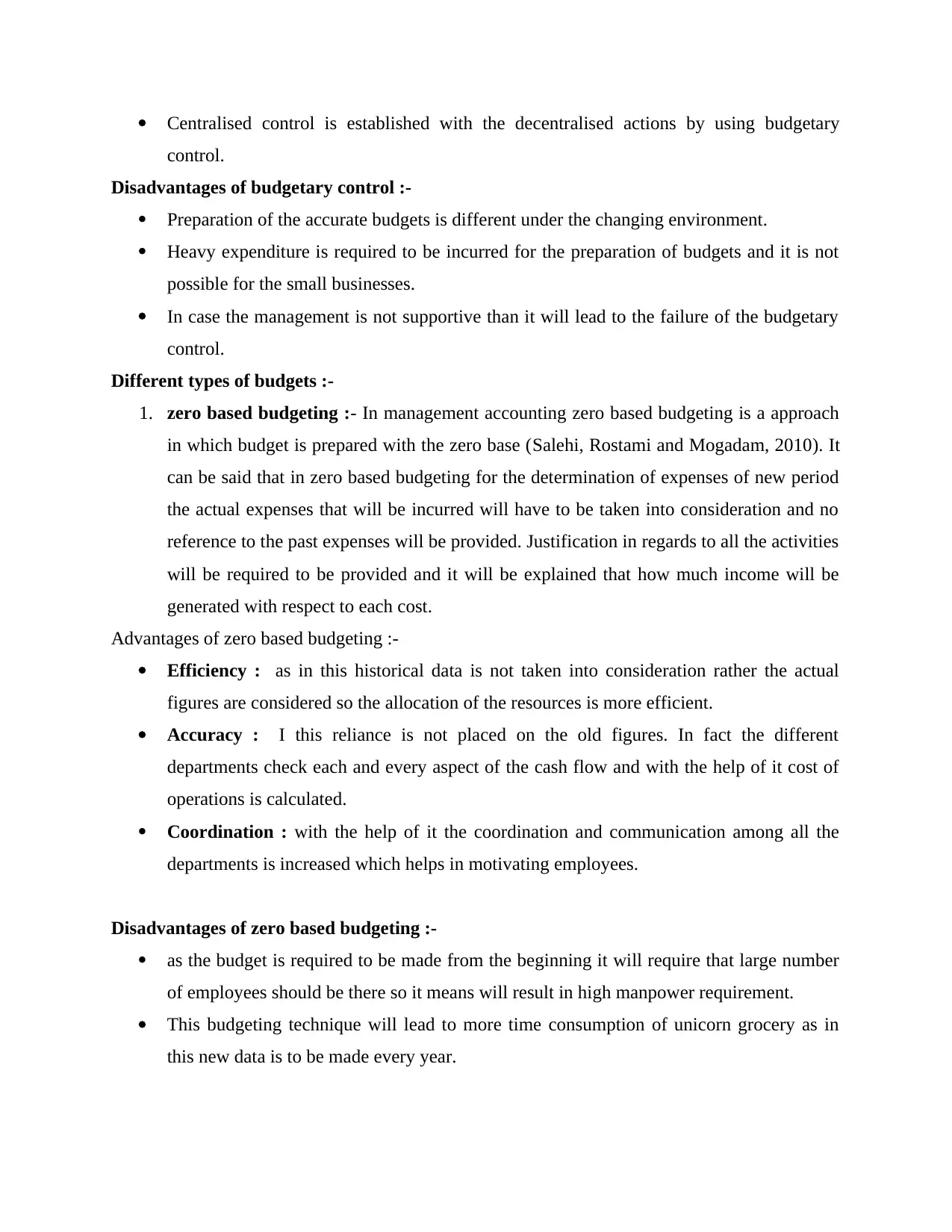
Centralised control is established with the decentralised actions by using budgetary
control.
Disadvantages of budgetary control :-
Preparation of the accurate budgets is different under the changing environment.
Heavy expenditure is required to be incurred for the preparation of budgets and it is not
possible for the small businesses.
In case the management is not supportive than it will lead to the failure of the budgetary
control.
Different types of budgets :-
1. zero based budgeting :- In management accounting zero based budgeting is a approach
in which budget is prepared with the zero base (Salehi, Rostami and Mogadam, 2010). It
can be said that in zero based budgeting for the determination of expenses of new period
the actual expenses that will be incurred will have to be taken into consideration and no
reference to the past expenses will be provided. Justification in regards to all the activities
will be required to be provided and it will be explained that how much income will be
generated with respect to each cost.
Advantages of zero based budgeting :-
Efficiency : as in this historical data is not taken into consideration rather the actual
figures are considered so the allocation of the resources is more efficient.
Accuracy : I this reliance is not placed on the old figures. In fact the different
departments check each and every aspect of the cash flow and with the help of it cost of
operations is calculated.
Coordination : with the help of it the coordination and communication among all the
departments is increased which helps in motivating employees.
Disadvantages of zero based budgeting :-
as the budget is required to be made from the beginning it will require that large number
of employees should be there so it means will result in high manpower requirement.
This budgeting technique will lead to more time consumption of unicorn grocery as in
this new data is to be made every year.
control.
Disadvantages of budgetary control :-
Preparation of the accurate budgets is different under the changing environment.
Heavy expenditure is required to be incurred for the preparation of budgets and it is not
possible for the small businesses.
In case the management is not supportive than it will lead to the failure of the budgetary
control.
Different types of budgets :-
1. zero based budgeting :- In management accounting zero based budgeting is a approach
in which budget is prepared with the zero base (Salehi, Rostami and Mogadam, 2010). It
can be said that in zero based budgeting for the determination of expenses of new period
the actual expenses that will be incurred will have to be taken into consideration and no
reference to the past expenses will be provided. Justification in regards to all the activities
will be required to be provided and it will be explained that how much income will be
generated with respect to each cost.
Advantages of zero based budgeting :-
Efficiency : as in this historical data is not taken into consideration rather the actual
figures are considered so the allocation of the resources is more efficient.
Accuracy : I this reliance is not placed on the old figures. In fact the different
departments check each and every aspect of the cash flow and with the help of it cost of
operations is calculated.
Coordination : with the help of it the coordination and communication among all the
departments is increased which helps in motivating employees.
Disadvantages of zero based budgeting :-
as the budget is required to be made from the beginning it will require that large number
of employees should be there so it means will result in high manpower requirement.
This budgeting technique will lead to more time consumption of unicorn grocery as in
this new data is to be made every year.
⊘ This is a preview!⊘
Do you want full access?
Subscribe today to unlock all pages.

Trusted by 1+ million students worldwide
1 out of 18
Related Documents
Your All-in-One AI-Powered Toolkit for Academic Success.
+13062052269
info@desklib.com
Available 24*7 on WhatsApp / Email
![[object Object]](/_next/static/media/star-bottom.7253800d.svg)
Unlock your academic potential
Copyright © 2020–2025 A2Z Services. All Rights Reserved. Developed and managed by ZUCOL.





